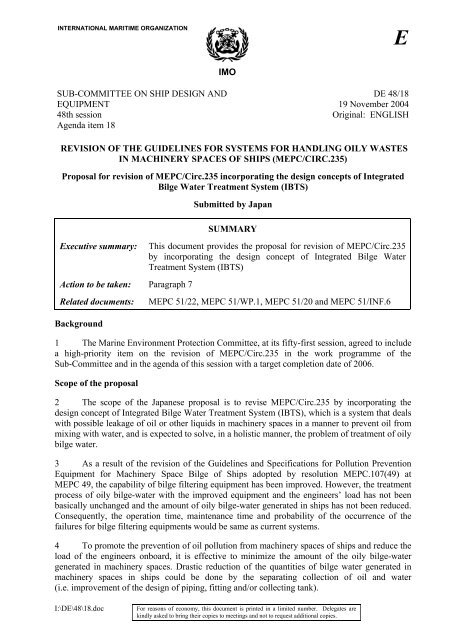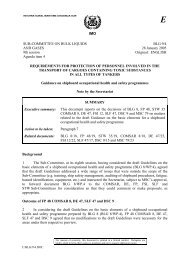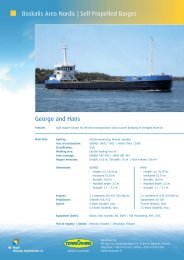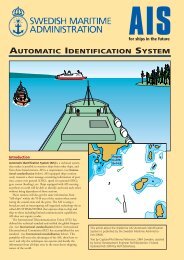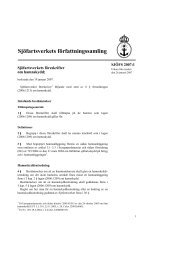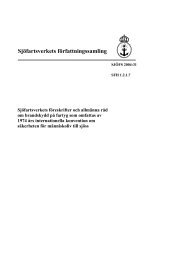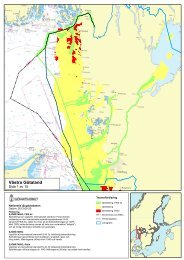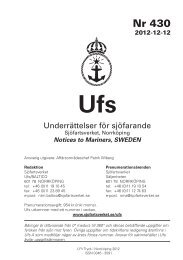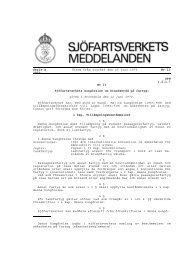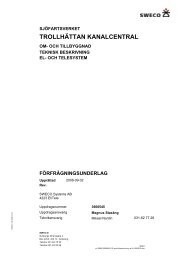IMO SUB-COMMITTEE ON SHIP DESIGN AND EQUIPMENT 48th ...
IMO SUB-COMMITTEE ON SHIP DESIGN AND EQUIPMENT 48th ...
IMO SUB-COMMITTEE ON SHIP DESIGN AND EQUIPMENT 48th ...
You also want an ePaper? Increase the reach of your titles
YUMPU automatically turns print PDFs into web optimized ePapers that Google loves.
INTERNATI<strong>ON</strong>AL MARITIME ORGANIZATI<strong>ON</strong><br />
E<br />
<strong>IMO</strong><br />
<strong>SUB</strong>-<strong>COMMITTEE</strong> <strong>ON</strong> <strong>SHIP</strong> <strong>DESIGN</strong> <strong>AND</strong><br />
<strong>EQUIPMENT</strong><br />
<strong>48th</strong> session<br />
Agenda item 18<br />
DE 48/18<br />
19 November 2004<br />
Original: ENGLISH<br />
REVISI<strong>ON</strong> OF THE GUIDELINES FOR SYSTEMS FOR H<strong>AND</strong>LING OILY WASTES<br />
IN MACHINERY SPACES OF <strong>SHIP</strong>S (MEPC/CIRC.235)<br />
Proposal for revision of MEPC/Circ.235 incorporating the design concepts of Integrated<br />
Bilge Water Treatment System (IBTS)<br />
Executive summary:<br />
Action to be taken: Paragraph 7<br />
Related documents:<br />
Background<br />
Submitted by Japan<br />
SUMMARY<br />
This document provides the proposal for revision of MEPC/Circ.235<br />
by incorporating the design concept of Integrated Bilge Water<br />
Treatment System (IBTS)<br />
MEPC 51/22, MEPC 51/WP.1, MEPC 51/20 and MEPC 51/INF.6<br />
1 The Marine Environment Protection Committee, at its fifty-first session, agreed to include<br />
a high-priority item on the revision of MEPC/Circ.235 in the work programme of the<br />
Sub-Committee and in the agenda of this session with a target completion date of 2006.<br />
Scope of the proposal<br />
2 The scope of the Japanese proposal is to revise MEPC/Circ.235 by incorporating the<br />
design concept of Integrated Bilge Water Treatment System (IBTS), which is a system that deals<br />
with possible leakage of oil or other liquids in machinery spaces in a manner to prevent oil from<br />
mixing with water, and is expected to solve, in a holistic manner, the problem of treatment of oily<br />
bilge water.<br />
3 As a result of the revision of the Guidelines and Specifications for Pollution Prevention<br />
Equipment for Machinery Space Bilge of Ships adopted by resolution MEPC.107(49) at<br />
MEPC 49, the capability of bilge filtering equipment has been improved. However, the treatment<br />
process of oily bilge-water with the improved equipment and the engineers’ load has not been<br />
basically unchanged and the amount of oily bilge-water generated in ships has not been reduced.<br />
Consequently, the operation time, maintenance time and probability of the occurrence of the<br />
failures for bilge filtering equipments would be same as current systems.<br />
4 To promote the prevention of oil pollution from machinery spaces of ships and reduce the<br />
load of the engineers onboard, it is effective to minimize the amount of the oily bilge-water<br />
generated in machinery spaces. Drastic reduction of the quantities of bilge water generated in<br />
machinery spaces in ships could be done by the separating collection of oil and water<br />
(i.e. improvement of the design of piping, fitting and/or collecting tank).<br />
I:\DE\48\18.doc<br />
For reasons of economy, this document is printed in a limited number. Delegates are<br />
kindly asked to bring their copies to meetings and not to request additional copies.
DE 48/18 - 2 -<br />
5 To materialize and disseminate the above-mentioned brand-new concept for the<br />
protection of marine environment, Japan prepared the draft guidelines for the Integrated Bilge<br />
Treatment System (IBTS), attached as appendix 2 of the annex to this document.<br />
6 Japan proposes that the draft MEPC Circular prepared in the annex, for MEPC/Circ.235,<br />
reviewed to harmonize with the current rules of the Convention and added newly draft guidelines<br />
for the Integrated Bilge Treatment System (IBTS) by Japan.<br />
Action requested of the Sub-Committee<br />
7 The Sub-Committee is invited to consider the above proposal and the annex and take<br />
action as appropriate.<br />
***<br />
I:\DE\48\18.doc
DE 48/18<br />
ANNEX<br />
Draft<br />
REVISI<strong>ON</strong> TO THE GUIDELINES FOR SYSTEMS FOR H<strong>AND</strong>LING OILY<br />
WASTES IN MACHINERY SPACES OF <strong>SHIP</strong>S<br />
<strong>AND</strong><br />
THE GUIDELINES FOR THE<br />
INTEGRATED BILGE TREATMENT SYSTEM (IBTS)<br />
(For the purpose of drafting, the parts with underline are added, and the parts with deletion line<br />
are deleted.)<br />
1 Annex I of the International Convention for the Prevention of Pollution from Ships, 1973,<br />
as modified by the Protocol of 1978 relating thereto (MARPOL 73/78), contains certain<br />
regulations and unified interpretations related to equipment for the storage, handling and disposal<br />
of oily residues and engine-room oily bilge-water.<br />
2 In order to facilitate the work of Administrations on systems for handling oily wastes in<br />
machinery spaces of ships, the Marine Environment Protection Committee (MEPC) has<br />
continuously reviewed an appropriate technology for fulfillment of the Convention requirements.<br />
3 “Guidelines for system for handling oily wastes in machinery spaces of ships”<br />
appendixed to this circular MEPC/Circ.235 were developed as are guidance for<br />
Administrations, shipowners and shipbuilders for consideration in achieving an efficient and<br />
effective system for the handling of oily bilge-water and oily residues for ships the keels of<br />
which are laid on or after 1 January 1992 and, where practicable, ships already in service.<br />
4 The aforementioned Guidelines are reviewed in accordance with the current provisions of<br />
the Convention and revised as appendix 1 to this circular.<br />
5 For further prevention of oil pollution from machinery spaces of ships, MEPC consider<br />
that the reduction of the generation of oily bilge water generated in machinery spaces is effective<br />
and noted the concept of Integrated Bilge Treatment System (IBTS) which incorporates the<br />
means to reduce the amount of oily bilge water and process the oily bilge water and oil residue<br />
(sludge) integratedly.<br />
6 MEPC recognized the need to disseminate the concept of IBTS and developed the<br />
Guidelines for IBTS as Appendix 2 to this circular.<br />
I:\DE\48\18.doc
DE 48/18<br />
ANNEX<br />
Page 2<br />
I:\DE\48\18.doc<br />
APPENDIX 1<br />
REVISED GUIDELINES FOR SYSTEMS FOR H<strong>AND</strong>LING OILY<br />
WASTES IN MACHINERY SPACES OF <strong>SHIP</strong>S<br />
1 Annex I of the MARPOL 73/78 contains certain regulations and unified interpretations<br />
related to equipment for the storage, handling and disposal of oily residues and engine-room oily<br />
bilge-water.<br />
2 In the continuous review by the MEPC of appropriate technology for fulfilment of the<br />
Convention requirements, substantial information has been collected which is valuable in the<br />
design, approval and surveying of installations in engine-rooms for systems handling oily bilgewater,<br />
and oily residues, but does not form part of the Convention regulations or the related<br />
interpretations.<br />
3 The MEPC had decided that this information is, nevertheless, of substantial value to<br />
Administrations, shipowners and shipbuilders and, accordingly, decided that the dissemination of<br />
the information should be in the format of an MEPC circular.<br />
4 The information contained in these Guidelines should be regarded as guidance in<br />
achieving an efficient and effective system for the handling of oily bilge-water and oily residues<br />
for new buildings and, where applicable and reasonable, for ships which are in service. The<br />
information should be considered in conjunction with specific conditions and circumstances,<br />
shipowners' and shipbuilders' practices, classification society rules, Administration requirements,<br />
etc., applicable to specific ship.<br />
5 Definitions for the purpose of these Guidelines in this Appendix<br />
5.1 Oily waste means oil residues (sludge) and oily bilge-water.<br />
5.2 Oil residue (sludge) means:<br />
.1 separated sludge, which means sludge resulting from purification of fuel and<br />
lubricating oil;<br />
.2 drain and leakage oil, which means oil resulting from drainages and leakages in<br />
machinery spaces; and<br />
.3 exhausted oils, which means exhausted lubricating oil, hydraulic oil or other<br />
hydrocarbon-based liquid which are not suitable for use in machinery due to<br />
deterioration and contamination.<br />
5.3 Sludge tanks mean:<br />
.1 tanks for separated sludge;<br />
.2 drain and leakage oil tanks; and<br />
.3 exhausted oil tanks.<br />
5.4 Bilge-water holding tanks mean tanks for oily bilge-water.
DE 48/18<br />
ANNEX<br />
Page 3<br />
5.5 Regulations referred to in these Guidelines are those contained in Annex I of<br />
MARPOL 73/78.<br />
5.6 Oil sludge incinerators are systems serving for incineration of oil sludge generated on<br />
board seagoing ships.<br />
Sludge incinerators could be:<br />
- main and auxiliary steam boilers with appropriate oil sludge processing systems;<br />
- heaters of thermal fluid systems with appropriate oil sludge processing systems;<br />
- incinerators with appropriate oil sludge processing systems designed for sludge<br />
incineration; or<br />
- inert gas systems with appropriate oil sludge processing systems.<br />
6 Collection and storage of oily wastes<br />
6.1 A sludge tank or tanks are mandatory under regulation 17.<br />
6.2 A bilge-water holding tank is arranged to receive the daily generation of bilge-water<br />
before this water is discharged ashore or discharged through the 15 ppm or 100 ppm equipment<br />
overboard. A bilge-water holding tank is not mandatory, but will enable ships to operate safely<br />
during port visits, during operation in special areas and coastal waters and during periods of<br />
maintenance of the 15 ppm or 100 ppm equipment.<br />
6.3 A bilge-water holding tank will also provide additional safeguards in the purification of<br />
oily bilge-water should quick-separating detergents be used for cleaning purposes.<br />
7 Arrangements of oily waste tanks<br />
7.1 Tanks for the purposes mentioned above should be arranged to satisfy the intended<br />
service of the ship.<br />
7.2 Sludge tanks may be separate and independent but may also be combined, as suitable,<br />
depending on the size and the service of the ship.<br />
7.3 The merits of arranging an independent tank for the collection of separated sludge should<br />
be considered, having regard to the smaller tank volume that needs to have cleaning and heating<br />
arrangements and the reduced space requirement for tank capacity that should preferably be<br />
arranged above the tank top.<br />
7.4 If a bilge-water holding tank is arranged, it should be separate and independent from<br />
other tanks for the collection of sludge.<br />
7.5 Ships operating with residual fuel oil of a relative density greater than 0.94 at 15°C<br />
should be provided with a bilge-water holding tank of adequate capacity and fitted with heating<br />
facilities to preheat the oily mixture prior to the discharge of the tank's contents to the sea<br />
through or 100 ppm or 15 ppm equipment.<br />
I:\DE\48\18.doc
DE 48/18<br />
ANNEX<br />
Page 4<br />
8 Size of oily waste tanks<br />
8.1 Tanks for collection of oily waste from various functions in the engine-room should have<br />
adequate capacity, having regard to the intended type of service of the ship. The information<br />
given below will provide guidance in this respect, but all other aspects applicable to the specific<br />
vessel trading pattern and time in port should additionally be taken into account.<br />
8.2 The recommended capacity for oil residue (sludge) tanks is specified in the interpretations<br />
to regulation 17.<br />
8.3 If an exhausted oil tank is installed, in addition to the requirement under regulation 17, it<br />
should be of sufficient capacity to receive lubricating oil or other oils and hydrocarbon-based<br />
liquids from engine-room systems being exhausted due to deterioration, contamination or due to<br />
maintenance activities. The oil being discharged from the 15 ppm and 100 ppm equipment may<br />
also be discharged to this tank. For main and auxiliary engines, which require a complete change<br />
of the lubricating oil at sea, the capacity of the tank should be determined as 1.5 m³ for each<br />
1,000 kW engine rating.<br />
8.4 If a drain and leakage oil tank is installed, in addition to the requirement under regulation<br />
17 it may be arranged at several locations in the engine-room. The oil being discharged from the<br />
15 ppm and 100 ppm equipment may also be discharged to this tank. The recommended capacity<br />
should be as follows:<br />
I:\DE\48\18.doc<br />
Main engine rating (kW) Capacity (m³)<br />
up to 10,000 20 x D x p/10 6<br />
above 10,000 D x (0.2 + 7 x (P-10,000)/10 6 )<br />
where, D = days; the same length of the voyage as used in the interpretation to<br />
regulation 17.<br />
P = main engine rating in kW.<br />
8.5 Bilge-water holding tanks, if fitted, should have a capacity that provides to the ship the<br />
flexibility of operation in ports, coastal waters and special areas, without the need to discharge<br />
deoiled water overboard. The operational merit of not having to operate the 15 ppm and 100 ppm<br />
equipment frequently should also be considered. The capacity of bilge-water holding tanks<br />
should be as follows:<br />
Main engine rating (kW) capacity (m³)<br />
up to 1,000 1.5<br />
Above 1,000 up to 20,000 1.5 + (P-1,000)/1,500<br />
Above 20,000<br />
14.2 + 0.2 (P-20,000)/1,500<br />
where, P = main engine rating in kW<br />
9 Pumping, piping and discharge systems in machinery spaces<br />
9.1 On board ships, the propulsion systems of which are operated by heavy fuel oil, the<br />
following guidelines are provided for the piping system comprising the plant components for the<br />
treatment and storage of oily bilge-water, separated sludge, drain and leakage oil and exhausted<br />
oil.<br />
9.2 The effluent from the 15 ppm and 100 ppm equipment should be capable of being<br />
recycled to the bilge or bilge-water holding tank.
DE 48/18<br />
ANNEX<br />
Page 5<br />
9.3 If an integral pump is fitted, the discharge should not bypass the 15 ppm or 100 ppm<br />
equipment.<br />
9.4 The discharge piping system of the 15 ppm and 100 ppm equipment should be completely<br />
separate from the bilge pumping and ballast water system except the recycling line referred to in<br />
paragraph 9.2.<br />
9.5 The ship's discharge pipeline for oily wastes to the standard discharge connection should<br />
be separated from the bunker fuel oil.<br />
9.6 The separated dirty water and exhausted control water of fuel oil purifiers should be<br />
discharged into a particular tank for this purpose in order to minimize the influx to the tank for<br />
separated sludge. This particular tank should be located above the double bottom for the purpose<br />
of facilitating its drain without the need of a drain pump. If dirty water and exhausted control<br />
water from purifiers is not discharged to a particular tank, and in lieu of this to a tank for<br />
separated sludge, the tank should be located above the double bottom for the purpose of the<br />
aforementioned draining facilities.<br />
9.7 Piping to and from sludge tanks shall have no direct connection overboard, other than the<br />
standard discharge connection required by regulation 19.<br />
NOTE:<br />
Subparagraph 9.7 will become mandatory when paragraph 3 of regulation 17 of Annex I of<br />
MARPOL 73/78 comes into force. In existing ships having piping connections to overboard<br />
discharge outlets, compliance with this requirement may be met by the installation of blanks in<br />
such pipings.<br />
10 Systems for separated sludge<br />
10.1 Tanks for separated sludge and their pipework<br />
Tanks for separated sludge, their pipework and pumps should be designed as follows:<br />
10.1.1 Size of tanks<br />
See subparagraph 8.<br />
10.1.2 Design of tanks and tank heating systems<br />
The tanks and tank heating systems should be designed to the satisfaction of the Administration.<br />
10.1.3 Tank heating system<br />
Tanks for separated sludge should be equipped with tank heating systems. The heating pipes<br />
should be arranged such that, seen from the heating inlet, to start with they are arranged in a way<br />
of the boundaries and then across the whole bottom area sufficiently high, in order to avoid being<br />
covered totally by sediments in the tank:<br />
The tank heating system should be designed such as to enable heating of the oil sludge up<br />
to 60°C.<br />
The suction line from the sludge tank to the pump should be provided with heat tracing.<br />
I:\DE\48\18.doc
DE 48/18<br />
ANNEX<br />
Page 6<br />
10.1.4 Pipelines from the heavy fuel oil purifier to the tank<br />
Whenever possible, the sludge tank should be located below the heavy fuel oil purifier. If this is<br />
not possible, the sludge tank should be situated close to the heavy fuel oil purifier in such a way<br />
that the discharge line to the tank can be installed at the maximum gradient. The pipelines should,<br />
wherever possible, be straight or fitted with large radius elbows.<br />
10.1.5 The submersible pump or opening of the suction line should be arranged so that the oil<br />
sludge's path to the suction opening is as short as possible, or the sludge tank should be mounted<br />
or designed, so that the oil sludge moves down a slope towards the suction opening. The<br />
openings should be placed as wide as possible in the frames above the tank bottom in such a way<br />
that the oil sludge has free access to the suction line.<br />
10.1.6 Pump and pressure lines<br />
The pump should be suitable for use with high viscosity oil sludge, e.g. "self-priming<br />
displacement pump", with suitable means for protection against dry running. It should have a<br />
total head of at least 4 bar, and the delivery rate should be determined by applying the formula:<br />
Q = v /t (m³/h)<br />
where V is the volume of the sludge tank as calculated by the interpretation to regulation<br />
17. Four hours should be substituted for the time t. However, the pumping capacity<br />
should be not less than 2.0 m³/h.<br />
The geodetic suction head of the pump should not exceed 3.0 m for ships with main<br />
engine rating up to 15,000 kW and 3.5 m for ships greater than 15,000 kW.<br />
The pressure side of the pump should only be connected to the transfer line on deck, to<br />
sludge tanks and to the incineration equipment, if provided.<br />
10.1.7 Sludge tank design to facilitate cleaning<br />
Access holes should be arranged so that all areas of the tank can be cleaned. An access hole<br />
should be sited on top of the tank to facilitate the use of a portable pump.<br />
10.1.8 Steaming-out lines<br />
The top of sludge tanks should be fitted with steaming-out lines for cleaning.<br />
11 Example of an on-board system for oil sludge incineration<br />
11.1 General<br />
11.1.1 In addition to the provision of sludge tanks, another means for the disposal of oil residue<br />
(sludge) are oil sludge incinerators.<br />
11.2 Oil sludge incinerators<br />
I:\DE\48\18.doc
DE 48/18<br />
ANNEX<br />
Page 7<br />
11.2.1 An oil sludge incinerator system is composed of:<br />
- steam boiler or heater of thermal fluid systems or an incinerator;<br />
- oil burner;<br />
- oil sludge processing system; and<br />
- tanks for separated sludge.<br />
11.3 Oil sludge processing systems<br />
11.3.1 The oil sludge processing system consists of:<br />
- tank for mixing oil residues with fuel oil (mixing tank);<br />
- oil sludge preheating system;<br />
- filter; and<br />
- homogenization system.<br />
11.4 Mixing tank<br />
11.4.1 The mixing tank should be provided in addition to the tank for separated sludge. It should<br />
be equipped with suitable drainage facilities. With a view to improving combustibility and<br />
calorific value, a fuel oil supply connection should be provided.<br />
11.5 Homogenization system<br />
11.5.1 The homogenization system should assure that the entire contents of the mixing tank<br />
should be processed into a homogenous and combustible mixture. This system should be put into<br />
operation, following adequate draining of the tank. A device for continuous indication and<br />
monitoring of the water content of the oil sludge should be provided.<br />
I:\DE\48\18.doc
DE 48/18<br />
ANNEX<br />
Page 8<br />
1 Introduction<br />
APPENDIX 2<br />
Guidelines for the Integrated Bilge Treatment System (IBTS)<br />
1.1 Bilge is generated by the leakage of water and oil from the equipment and piping or<br />
maintenance works resulting from the routine operation in machinery space of ships. Such leaked<br />
oil and water are usually mixed and collected on the tank top or bilge wells as oily bilge-water.<br />
1.2 Oily bilge-water shall be treated in accordance with the requirements of Convention. This<br />
operation of such treatment, including the operation and maintenance of bilge filtering<br />
equipment, is a heavy load of engineers onboard.<br />
1.3 By the revision of the Guidelines and Specifications for Pollution Prevention Equipment<br />
for Machinery Space Bilge of Ships adopted by resolution MEPC.107(49), the capability of bilge<br />
filtering equipment has been improved. However, the treatment process of oily bilge-water with<br />
the improved equipment and the engineers’ load will be basically unchanged and the amount of<br />
oily bilge-water generated in ships has not been reduced.<br />
1.4 To promote the prevention of oil pollution from machinery spaces of ships and reduce the<br />
load of the engineers onboard, it is effective to minimize the amount of the oily bilge-water<br />
generated in machinery spaces.<br />
1.5 MEPC noted the design with the concept of Integrated Bilge Treatment System (IBTS)<br />
which incorporates the means to minimize the amount of oily bilge-water and proceed the oily<br />
bilge-water and oil residue (sludge) as a drastic solution to prevent oil pollution from machinery<br />
spaces of ships.<br />
1.6 MEPC recognized the need to disseminate the concept of IBTS and decided to provide<br />
the guidelines on IBTS.<br />
1.7 The purpose of these guidelines is to provide shipowners and shipbuilders with<br />
information to help the design of the ship incorporating the concept of IBTS.<br />
2 Concept of Integrated Bilge Treatment System (IBTS)<br />
2.1 Integrated Bilge Treatment System (IBTS) is a system to minimize the amount of the oily<br />
bilge-water generated in machinery spaces by means to treat the leaked water and oil separately<br />
and also provides integrated means to process the oily water and oil residue (sludge).<br />
3 Definitions for the purposes of these Guidelines in this Appendix<br />
3.1 Clean drains mean drains resulting from the leakage of equipment used for sea water,<br />
fresh water, steam etc. which are not contaminated by oil.<br />
3.2 Oily drains mean drains resulting from the leakage of equipment used for oil.<br />
I:\DE\48\18.doc
DE 48/18<br />
ANNEX<br />
Page 9<br />
3.3 Oily bilge-water means water collected in the bilge wells or the tank top resulting from<br />
the unexpected leakage from piping or the maintenance work in machinery spaces, which may be<br />
contaminated by oil.<br />
3.4 Oil residue (sludge) : refer to 5.2 of appendix 1. It includes oily drains.<br />
3.5 Bilge primary tank means a pre-treatment unit for separation of oily bilge-water.<br />
4 Outlines of IBTS<br />
4.1 Collection of drains<br />
.1 Oily drains are collected through the fixed drainage arrangements to sludge tanks.<br />
.2 Clean drains are collected through the fixed drainage arrangements to clean drain<br />
tanks.<br />
.3 Oily drain and clean drain shall be collected separately so as not to contaminate clean<br />
drains with oil.<br />
4.2 Pre-treatment of oily bilge-water<br />
To avoid feeding excessive oil to oil filtering equipment, oily bilge-water in the bilge wells is<br />
transferred to the bilge primary tank for pre-separation of oil. The high oil contained water is<br />
transferred to sludge tanks and the low oil contained water is transferred to the bilge water tank.<br />
4.3 Discharge of oily bilge-water<br />
Oily bilge-water in the bilge water tank is discharged overboard through the oil filtering<br />
equipment in accordance with Reg.16 of the Convention.<br />
4.4 Discharge of clean drains<br />
Clean drains may be discharged overboard directly through the discharge arrangement<br />
independent from the system for oily bilge-water or oil.<br />
4.5 Treatment of oil residue (sludge)<br />
.1 Oil residue (sludge) in sludge tanks is transferred to the waste oil tanks.<br />
.2 Water in oil residue (sludge) is vaporized at the waste oil tanks by heating.<br />
.3 Oil residue (sludge) is incinerated by the sludge incinerator or discharged to the<br />
reception facilities through the standard shore connection.<br />
.4 Oily drains from fuel oil systems may be burnt by the boiler as re-generative fuel.<br />
5 Additional installations of IBTS<br />
In addition to the installations required by the Conventions, the following installations are<br />
required to compose IBTS:<br />
5.1 Drainage system<br />
.1 Drip trays or coamings with sufficient depth provided under the equipment used for<br />
oil such as diesel engines, burners, pumps, heaters, coolers, filters, and tanks to keep<br />
spillage of oil.<br />
.2. Drip trays or coamings with sufficient depth provided under the equipment used for<br />
water such as pumps, heaters, coolers, filters, tanks, condensers and boilers to keep<br />
spillage of water.<br />
.3 Independent drainage arrangements for oil and water to sludge tanks and the clean<br />
drain tank.<br />
I:\DE\48\18.doc
DE 48/18<br />
ANNEX<br />
Page 10<br />
5.2 Pre-treatment unit for oil separation<br />
Bilge primary tank with construction of cascade, which is able to separate oil from oily bilgewater<br />
by gravity with drainage facilities of the oil on the top as primary separation of oily bilgewater.<br />
Refer to the example of bilge primary tank shown in Fig. 1.<br />
Fig. 1 Example of bilge primary tank<br />
5.3 Storage tanks<br />
.1 Clean drain tank : Tank for the retention of clean drains<br />
.2 Bilge water tank : Tank for the retention of oily bilge-water<br />
.3 Waste oil tank : Tank for preparation of oil residue (sludge) for incineration<br />
5.4 Discharge arrangement of clean drains<br />
The discharge arrangement of clean drains to overboard should be independent from the system<br />
for oily bilge-water.<br />
5.5 Exclusive pump for the oil filtering equipment<br />
It is preferable to be provided with an exclusive pump to transfer the pre-treated bilge water from<br />
bilge tank to the oil filtering equipment so as not to mix the pre-treated oily -water and untreated<br />
oily bilge-water.<br />
5.6 Heating arrangement<br />
.1 Heating arrangement of the bilge primary tank to facilitate separation of oil.<br />
.2 Heating arrangement of the waste oil tank to vaporize water and facilitate incineration<br />
6 Example of IBTS<br />
A typical flow diagram of IBTS is shown in Fig. 2.<br />
I:\DE\48\18.doc
DE 48/18<br />
ANNEX<br />
Page 11<br />
Clean Drains<br />
Main engine air cooler air drain<br />
Oil residues (sludge)<br />
Hydraulic oil pump & tank coaming drain<br />
Cooling fresh water, Sea water<br />
Waste oil pump & tank coaming drain<br />
Steam drain, Boiler<br />
water<br />
LO pump & tank coaming drain<br />
Bilge equipment coaming drain<br />
Overboard<br />
Pump<br />
Clean<br />
drain tank<br />
Main engine piston<br />
underside<br />
Oily bilge-water<br />
Compressed air drain<br />
Engine room scupper<br />
(leakage from pipelines)<br />
Purifier sludge<br />
Pump<br />
Oil mist drain<br />
Bilge well<br />
Work shop<br />
drain<br />
Bilge<br />
Separator<br />
Sludge tank<br />
Reception<br />
facilities<br />
Waste oil tank<br />
Pump<br />
Bilge<br />
alarm<br />
Overboard<br />
Pump<br />
Bilge<br />
Primary tank<br />
Incinerator<br />
Boiler<br />
Boiler FO<br />
settling tank<br />
FO pump & tank<br />
coaming drain<br />
FO filter drain<br />
Bilge water tank<br />
Pump<br />
FO drain tank<br />
Fig. 2 Flow Diagram of Integrated Bilge Water Treatment System (IBTS)<br />
_______________<br />
I:\DE\48\18.doc


